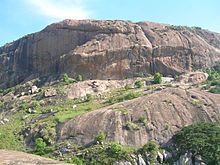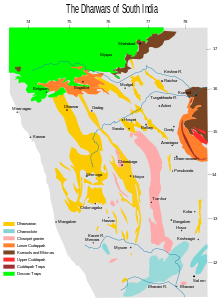- Ramanagara
-
This article is about the municipality in India. For its namesake district, see Ramanagara district.
Ramanagara — city — Coordinates 12°43′N 77°18′E / 12.72°N 77.3°ECoordinates: 12°43′N 77°18′E / 12.72°N 77.3°E Country India State Karnataka District(s) Ramanagara district Time zone IST (UTC+05:30) Ramanagara[1] (known as Closepet, after Sir Barry Close (1756–1813), in pre-Independence times and retained in geology) is a town and a city municipal council in the Indian state of Karnataka.It is also the headquarters of Ramanagara district.
Contents
Geography
Ramanagara is approximately 50 km southwest of Bangalore. It has an average elevation of 747 metres (2450 feet).
Demographics
As of 2001[update] India census,[2] Ramanagara had a population of 79,365. Males constitute 52% of the population and females 48%. Ramanagara has an average literacy rate of 63%, higher than the national average of 59.5%: male literacy is 67%, and female literacy is 58%. In Ramanagara, 13% of the population is under 6 years of age.
Figures for the district, which was carved out of Bangalore Rural in September 2007, are not available as yet.now its change to Ramanagram District
Educational Institutes
Ramanagara has educational institutes like Ghousia College of Engineering and Govt Engineering College. MH College of Education, Shantiniketan Group of institution, sharada B Ed D Ed college etc...........
Culture
Ramanagara has a rich heritage of cultural places like Janapada Loka "FOLK WORLD".
Economy
 The cocoon market at Ramnagara
The cocoon market at Ramnagara
Ramanagara is famous for its sericulture, and is nicknamed Silk Town & Silk City . The silk produced in this region forms the input for the famous Mysore Silk. Ramanagara is the largest market for silk cocoons in Asia.[citation needed] 50 tonnes of cocoon a day arrive at the town.[3]
Hills and landscape
Ramanagara is also famous some of the world's oldest granite outcrops. The hill Ramadevarabetta, along with Savandurga was one of the shooting locations for David Lean's A Passage to India. Small door like grottoes were made in the rock to resemble caves.[4] It was also in this region that the path-breaking Hindi movie, Sholay, was shot.
Other well known hills in the region include the Revanasideshwara hill and Handigundi. These hills have been threatened by quarrying and also plans to carve these hills into statues. The region is covered in scrub forest and is home to threatened bird species such as the Yellow-throated Bulbul and Long-billed Vultures.[5] The hill is today one of the few locations in south India where Long-billed Vultures nest. The region is also home to numerous sloth bears.[6] Tigers were found in the region in the 1900s.[7]
Closepet granites
The Closepet granites are a major geological feature of this region and are from the Lower Proterozoic era. This belt of rocks extend in the north-south direction in 50 km belt. This belt has younger potassic granites and is believed to separate two distinct crustal blocks of Archaean age. The block to the west has low grade granite-greenstone belts with iron-manganese ores and to the east are younger gneisses of granitic and granodioritic composition with gold-bearing schist belts.[8]
Climbing
Ramanagara hills have been the earliest rock climbing locations in South India. Climbers have been undertaking technical climbing since 1960s onwards. Those that are popular for rock climbing are; Ramadevarabetta, SRS betta and Thenginkalbetta.The region has several tall granitic hills which are famous for many short rock climbs, typically 1 to 2 pitches in length. Grades vary from 5.8 American to 5.11 American. Some of the interesting climbs are on the Wanakkal wall ("Gabbar ki asli pasand", "Labor pain"), on the Rainbow wall ("UIAA", "Kalia"), on Anna-Thamma ("Darkness at dawn", "Black Diamond", the name Anna-Thama means 'elder-brother-younger-brother' in Kannada). There are multiple bolted routes here, put up by various local climbers. Some of the older bolts are in precarious condition. There is very little free climbing possibilities as the rock is compact. Additionally, the forest department since a few years has been insisting on a permit system to climb here, and getting permits is typically a laborious process, considering that these have to be obtained during weekdays from a Forest office (Aranya Bhawan) close Ramanagara, thus precluding this place for Bangalore based climbers in recent times.[9]
See also
References
- ^ City of Ramanagara - City Municipal Council
- ^ "Census of India 2001: Data from the 2001 Census, including cities, villages and towns (Provisional)". Census Commission of India. Archived from the original on 2004-06-16. http://web.archive.org/web/20040616075334/http://www.censusindia.net/results/town.php?stad=A&state5=999. Retrieved 2008-11-01.
- ^ cocoon market
- ^ A Passage to India - locations Accessed December 2006
- ^ Subramanya, S. and Naveein, O. C. 2006. Breeding of Long-billed Vulture Gyps indicus at Ramanagara hills, Karnataka, India. Indian Birds 2(2):32 Full text[dead link]
- ^ [1][dead link]
- ^ CEM Russell (1900) Bullet and shot in Indian forest, plain and hill. W. Thacker & Co. scanned book
- ^ Atomic minerals directorate[dead link]
- ^ The beckoning monoliths
External links
Categories:- Climbing areas of India
- Cities and towns in Ramanagara district
Wikimedia Foundation. 2010.





